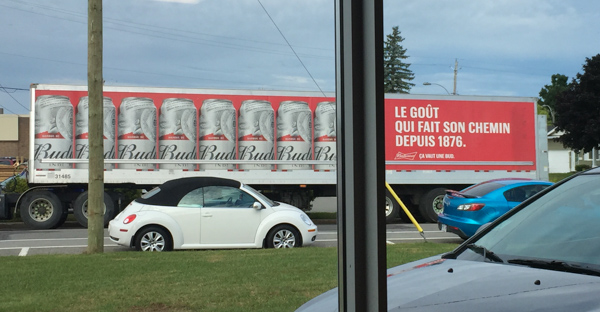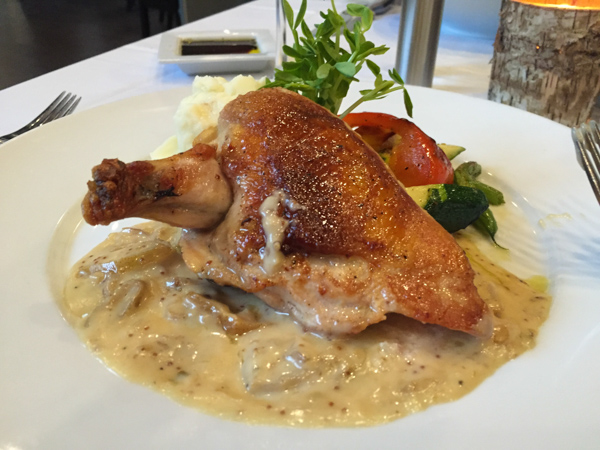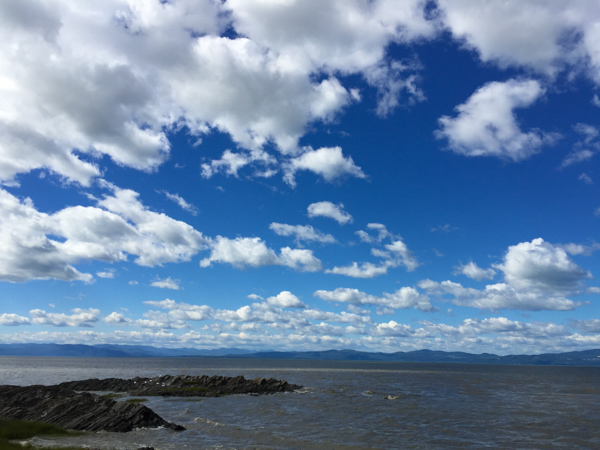- By Monroe Payne, Monroe Payne Photography
- Around Town
 Print
Print  Honest, I'll get closer to home next week, but I've gotta get this out of my system.
Honest, I'll get closer to home next week, but I've gotta get this out of my system.To the north of New York State are two very different countries. "Two?" you say? "Silly, there's only one, Canada". "Two!" I say – "there's Canada, and then there's Quebec."
Described as 'More French than France', Quebec is beautiful, friendly and the English language is never heard in conversation. Ever. Everywhere else in Canada, the road signs are dual language – well they are in New Brunswick and Nova Scotia. Ontario seems to be as English as Quebec is French. So consider this as a very short course in what you need to do to survive in France – excuse me, Quebec.
First, good accurate maps and a well-functioning GPS will help you a great deal. I believe that Quebec feels route markers and street signs are optional. On the TCH (Trans-Canada Highway) the signage is pretty good, as long as you know what '3 Prochaine Sorties' means (next three exits) and the like.

Also, gas stations and restaurants are not in every town like here. We had the great (but naive) idea of taking the slow road, Rt 132 next to the south shore of the St Lawrence River – or Fleuve Saint Laurent. After an hour or so of enjoying the beauty of the countryside and catching just enough glimpses of the number 132 to assure us we weren't lost, we decided to try to find a restaurant. Another 30 km (everything north of the border is kilometers) we hadn't seen even the hint of a shade of a possibility that Quebecers ever went out to eat.
I'm also low on gas. So we left 132, following the signs to a little town where we thought we might be able to find sustenance for both ourselves and the bike. After another half hour of fruitless search, Janet finally prevailed on me to ask for directions. Although the male in me rebelled, I finally saw the innate wisdom in her request.
A small grocery store appeared on the left, and I went inside. I'm glad the word 'restaurant' is the same in both languages. Through a little friendly gesticulating and drawing heavily on my high school French classes, we were directed to a restaurant nine miles – I mean kilometers - farther down the road. The gas station was a little harder to find – several blocks off of the not-so-main road, sporting ancient pumps – but at least they were operational. Esso. Remember Esso Gas?

Back on the street, the chance glimpse of a partially hidden road sign led us back to 132, where we continued our tourist's drive to near Quebec City. The St Lawrence is a magnificent river. At this point near St Jean Pont Joli, the river is many miles wider than Cayuga Lake at its widest, and fabulously beautiful. Even though the water near the shore was muddy from a recent rain, it still smelled delightfully fresh.
Reluctantly, we made our way back to the TCH to bypass Quebec City and Montreal. The driving from there to beyond Montreal was some of the most difficult I've ever encountered. Traffic was very dense and far too fast for me – but then I was staying the speed limit (damn tourist…) and wanted to keep my co-rider safe.

Dining in Quebec is very … French. Occasionally, you can find English in the menu, but it also seems to be optional. At the Hotel L'Oiselière, our stop for the evening in Montmagny, there is a restaurant called 'La Cuvee' that serves the most wonderful – everything, from the Onion Soup, to the Salmon (Saumon), and the stuffed chicken breast (poulet). And I thoroughly enjoyed the Crème Brûlée. I could figure that one all by myself…
The most common fast food chain on our route through Canada was Tim Horton's. Their offerings of food meet or exceed Dunkin Donuts here. We could always count on great coffee. I kinda wish the Ithaca store was still open…
 St. Lawrence River
St. Lawrence RiverNow for the advice part. Whatever you do, don't rush through Canada. Our biggest mistake was 'moving through' but not enjoying the beauty that is everywhere in Canada. Our resolve is next time, to pick a destination, stay there and explore, and come home. The St Lawrence and Quebec have some of the most beautiful lighthouses in the world. Next time.
Cash is almost unnecessary in today's traveling world, but credit cards have an annoying habit of charging a 'foreign currency conversion fee'. A small fee to be sure, but annoying because it eats away at the great exchange rate we now have versus Canada. If you have a bank that is both Canadian and US, you may be able to avoid the fees. I have a TD Ameritrade account which speaks very nicely to TD Bank in Canada. No fees.
One of the nice things about using credit/debit cards in Canada is that every business uses the same terminal. Maybe this makes tax collection easier – I don't know, but it's cool to have the waitress come to your table with the terminal, enter all the pertinent data in then discreetly turn around while you enter the tip, and then hand you the receipt.
When you DO need cash, be prepared. Canadian bills are colorful plastic with a clear section. Even the locals call it 'funny money', but it works ok for them. The dollar coin has a loon pictured, hence 'Loonies' for dollars. They have also eliminated pennies. They round to the nearest nickel.
 Our Faithful Steed
Our Faithful SteedThe English phrase every person in Quebec understands is "I'm sorry, I don't understand." They will dust off their rarely used English and help you to the very best of their ability.
I'll admit, when the 'Welcome to Ontario' sign came into view, I breathed a sigh of relief. I could understand the signs and it felt a bit more familiar, but though we were almost home, I remembered the kindness we were shown by our new friends in the 'other Country' of Quebec which is, if you wish, Within Reach.
'Within Reach' highlights the food, wine and fun of places 'within Reach' of Lansing NY. Of course, your reach extends exactly as far as you want it to. I am Monroe Payne, Uncle Monte to some. Come with me as I visit, taste and play in our own back yard, the beautiful Finger Lakes of Central New York.
v12i35



